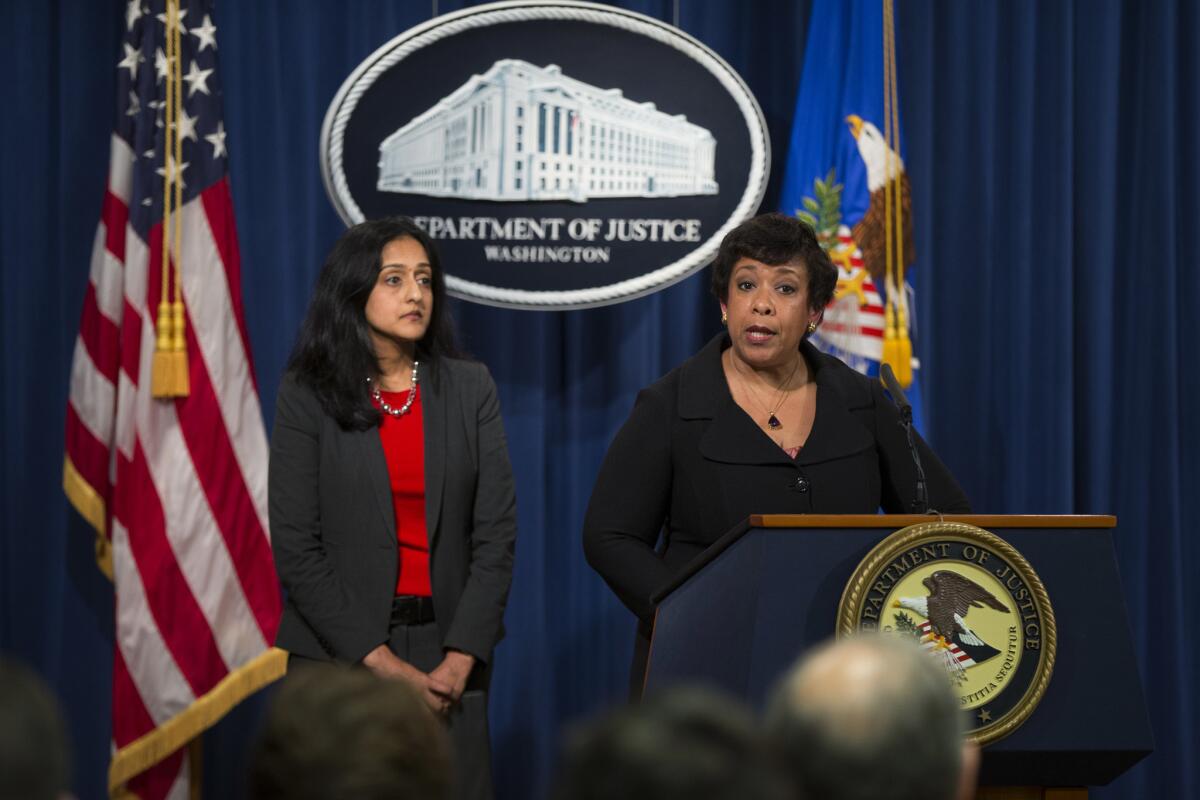Baltimore police routinely violated the rights of blacks, Justice Department report says

- Share via
Reporting from Washington — Baltimore police routinely violated the constitutional rights of residents by conducting unlawful stops and using excessive force, according to a long-anticipated Justice Department report being released Wednesday.
The practices were overwhelmingly directed at the city’s black residents in poor neighborhoods, the Justice Department concluded in a 163-page report, which was obtained by the Los Angeles Times.
Begun after the April 2015 death of Freddie Gray from injuries sustained while in police custody, the wide-ranging investigation uncovered deep-seated problems with how Baltimore officers do their jobs and how they are policed themselves.
The unlawful practices were “driven by systemic deficiencies in [the police department’s] policies, training, supervision and accountability structures that fail to equip officers with the tools they need to police effectively,” the report said.
Gray’s death, which triggered rioting, was one of several recent killings nationwide of unarmed black men by police officers. The deaths have provoked a nationwide conversation about race, discrimination and police practices. It also has exposed deep rifts between police and the communities they serve.
The Justice Department examined data from 2010 through 2015 and conducted extensive interviews with officers, prosecutors, community leaders and residents.
Among the findings: Baltimore police too often stopped, frisked and arrested residents without legal justification, and such activities fell disproportionately on black residents and drivers.
Officers also too frequently used excessive force in situations that did not call for aggressive measures, the report said, and routinely retaliated against residents for exercising their right to free speech and free assembly.
The investigation concluded that deeply entrenched problems were allowed to fester because the department did not properly oversee, train or hold accountable officers. For example, the department lacks systems to deter and detect improper conduct, and it fails to collect and analyze data that might root out abuses or abusers.
Federal investigators determined that 1990s-era policies that encouraged more aggressive policing, known as “zero tolerance,” contributed to the discriminatory practices, and that such measures were partially responsible for badly fraying the relationship between residents and police.
Vanita Gupta, who leads the Justice Department’s civil rights division, said such “zero tolerance” strategies and other aggressive tactics helps explain why residents lost faith in the department.
“The long-standing nature of these problems and the degree to which they infected so much of the relationship and interactions between law enforcement and Baltimore communities was pretty staggering,” Gupta said in an interview.
The Justice Department announced Wednesday it had reached an agreement in principal with city officials to negotiate a court-enforced consent decree to fully address the problems. Reforming the department will take years, require close oversight and cost millions of dollars, Justice Department officials said.
The agreement in principle “identifies categories of reforms the parties agree must be taken to remedy the violations of the Constitution and federal law described in this report.”
Such an agreement would be the first step in negotiations to reach a court-enforced consent decree.
In recent years, the Justice Department has completed numerous such “pattern or practice” investigations into local police departments around the country, including one after the 2014 shooting of an unarmed black man by Ferguson, Mo., police.
Baltimore officials invited the federal investigation after Gray’s death.
Gray died on April 19, 2015, after sustaining severe spinal cord injuries while being transported in the back of a police van. Hours after the 25-year-old’s funeral, protests and rioting erupted in Baltimore. City officials imposed nearly a week of curfew, along with the deployment of the state’s National Guard. More than 200 people were arrested over the days of unrest, and nearly 100 police officers were injured.
In welcoming the federal investigation, Baltimore Mayor Stephanie Rawlings-Blake said she was “willing to do what it takes to reform my department.”
The Justice Department has worked closely with the Baltimore police, which set up a team of officers and officials to deal directly with federal investigators. The report praised police and city leaders for their cooperation.
Baltimore Police Commissioner Kevin Davis said Tuesday that he looked forward to reviewing the federal findings. He said they would help him improve the force.
“We have begun this journey to reform long-standing issues in many real, tangible ways,” Davis said. “DOJ’s findings will serve to solidify our road map.”
Anticipating what the Justice Department would discover, city officials already have pushed forward on several fronts, revising the use-of-force policy and instituting new training. The department, for example, has redesigned and placed cameras in its police transport vans and introduced a software platform for the streamlined and tracked dissemination of new training materials and policies for officers; both are issues that arose in the Gray case.
Criminal prosecutions against the six officers involved in Gray’s arrest and transport have not gone as smoothly. Three were acquitted at a bench trial, and State’s Atty. Marilyn J. Mosby recently dropped the charges against the three remaining officers.
The Justice Department is separately reviewing whether federal civil rights violations occurred. But the legal hurdles for bringing a federal case are higher than those faced by state prosecutors.
“We will continue our independent review of this matter, assess all available materials and determine what actions are appropriate, given the strict burdens and requirements imposed by applicable federal civil rights laws,” Justice Department spokesman David Jacobs said in a statement.
MORE FROM NATION
From Ferguson to Baton Rouge: Deaths of black men and women at the hands of police
UPDATES:
7:45 p.m. Aug 10: This article was updated with information from a Justice Department news conference.
4:10 p.m.: This article was updated with details from the report.
The article was originally published at 12:25 p.m., Aug. 9.
More to Read
Sign up for Essential California
The most important California stories and recommendations in your inbox every morning.
You may occasionally receive promotional content from the Los Angeles Times.











